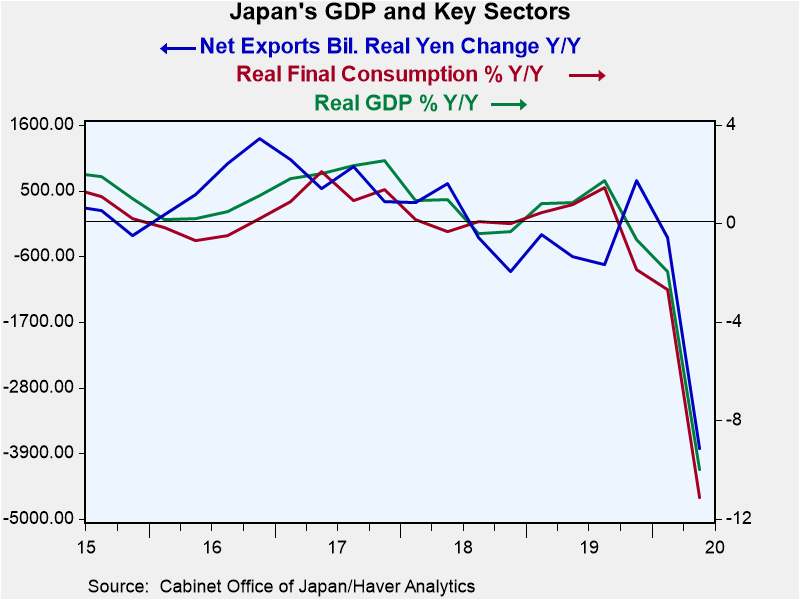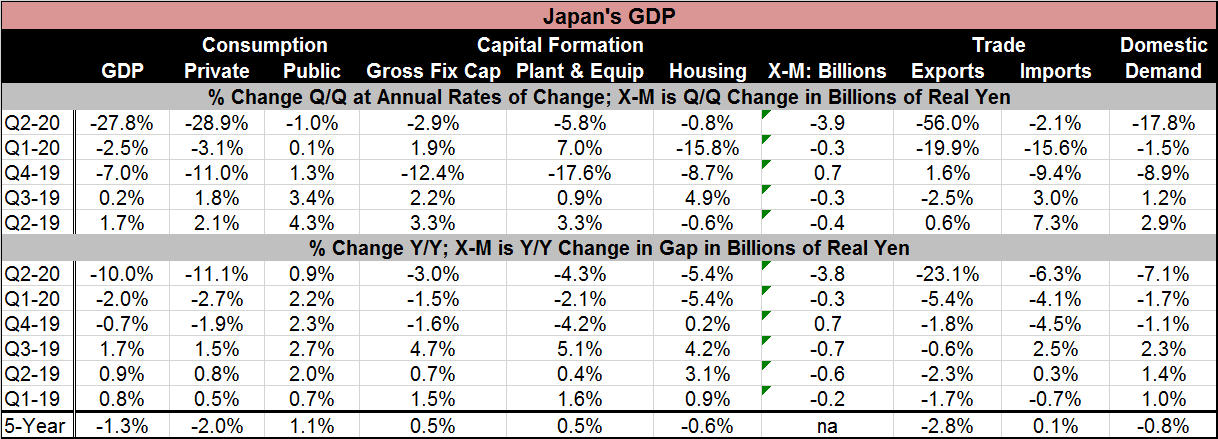 Global| Aug 17 2020
Global| Aug 17 2020Japan's GDP in Record Tailspin
Summary
GDP falls for third quarter in a row...it's not just the virus Japan's GDP made its worst fall in 40 years. The Cabinet Office says GDP shrank at an annualized 27.8% from the previous quarter in real terms. It's the worst result since [...]
 GDP falls for third quarter in a row...it's not just the virus
GDP falls for third quarter in a row...it's not just the virus
Japan's GDP made its worst fall in 40 years. The Cabinet Office says GDP shrank at an annualized 27.8% from the previous quarter in real terms. It's the worst result since comparable data became available in 1980.
Like in Europe and the United States, the drop was fueled by a stay-at-home edict to break the back of a threatening coronavirus. The government had declared a state of emergency in April and May. That hermitage caused personal consumption spending to fall sharply. Private consumption in GDP fell at a 28.9% annual rate after falling in each of the two previous quarters as well.
But it was not just a domestically generated catastrophe or simply an abatement of spending by consumers. Businesses pulled back on spending. The entire international community was hard hit and Japan's exports plummeted further damaging the economy.
Capital spending in Japan pulled back in Q2 and has fallen in two of the last three quarters. Gross fixed capital spending fell by 2.9% at an annual rate in Q2 while spending on capital equipment fell at a 5.8% annual rate. Both types of business spending fell in two of the last three quarters.
Residential investment was hit as well. Housing construction spending fell at a 0.8% rate, dropping for the third quarter in a row and for the fourth time in five quarters after a string of increases.
Exports were hit especially hard, driving net exports into a negative position. Exports fell in Q2 at a 56% annual rate as imports were reduced at a 2.1% annual rate. Exports are down sharply in each of the last two quarters and have fallen in three of the last for quarters. Imports have declined in more modest terms but for three quarters in a row.
The pullback has hit domestic demand in Japan exceptionally hard as it fell at a 17.8% annual rate in Q2 after falling in each of the two previous quarters as well. Japan has been hit with a pullback that is domestic in nature and international in scope. The domestic reaction to the virus hit hard while there was already the impact on trade flows from the U.S.-China trade dispute in progress. Then the global virus response worsened the global environment when the coronavirus was sprung on the world.
Year-over-year trends show the intensity and duration of Japan's suffering; it is not just from the virus even though the virus impact has been substantial. Japan's exports, for example, are down by 23.1% over four quarters; they have fallen year-over-year for six quarters in a row so that the sharp drop of exports in Q2 is from a Q2 level of one year ago that itself had already fallen year-over-year!
Year-on-year Japan's imports are off for three quarters running; the 12-month rate is -6.3%.
Private consumption in Japan has fallen year-over-year for three quarters running, as have both capital investment series.
Public spending has been only a mild counterforce during these periods of duress. In Q2 2020, public spending finally fell quarter-to-quarter. But government spending has generally been increasing and rose on a year-over-year basis for 13 quarters in a row though Q2 2020.
Japan shows that its economy has been adversely affected about every way possible and this has come after having been made collateral damage in the U.S.-China trade war that was under way in slow motion before the coronavirus hit. The Bank of Japan has been at the forefront of global efforts to provide monetary support, but Japan also faces a shrinking and aging population, two facets that make it more difficult to conjure up stimulus. One bright spot for Japan is that although economic activity has been hit hard and despite Japan's aged population, it has not been hit as hard by deaths caused by the virus. That is a surprise since old people in most countries have died at alarming rates. Still, Japan has suffered a second wave of impact from the virus that has just made recovery more difficult. Earlier this year, deaths in Japan reached 1,000 overall and have hovered at the mark. Only recently deaths have started to move above that level. Japan may have an economy under pressure, but even its old people remain relatively healthy and have not been as preyed upon by the coronavirus. Yet, none of that has been enough to help Japan escape the grip of economic malaise that all countries have suffered from the virus.

Robert Brusca
AuthorMore in Author Profile »Robert A. Brusca is Chief Economist of Fact and Opinion Economics, a consulting firm he founded in Manhattan. He has been an economist on Wall Street for over 25 years. He has visited central banking and large institutional clients in over 30 countries in his career as an economist. Mr. Brusca was a Divisional Research Chief at the Federal Reserve Bank of NY (Chief of the International Financial markets Division), a Fed Watcher at Irving Trust and Chief Economist at Nikko Securities International. He is widely quoted and appears in various media. Mr. Brusca holds an MA and Ph.D. in economics from Michigan State University and a BA in Economics from the University of Michigan. His research pursues his strong interests in non aligned policy economics as well as international economics. FAO Economics’ research targets investors to assist them in making better investment decisions in stocks, bonds and in a variety of international assets. The company does not manage money and has no conflicts in giving economic advice.






